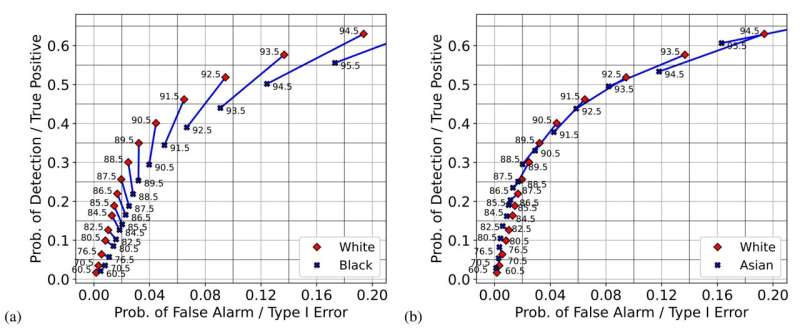This article has been reviewed according to Science X's editorial process and policies. Editors have highlighted the following attributes while ensuring the content's credibility:
fact-checked
trusted source
proofread
Bias from pulse oximeters remains even if corrected by race, study finds

Pulse oximeters were a critical part of life-saving care during the COVID-19 pandemic, shaping treatment by measuring oxygen levels in the blood. The devices, which became common in the 1980s, have long shaped protocols for detecting hypoxemia, low blood oxygenation that can lead to organ failure and death.
While decades of published research have shown that pulse oximeters can give biased readings for patients with dark skin, a team of researchers at Washington University in St. Louis is reporting that suggested raced-based adjustments to hypoxemia thresholds are insufficient; instead, researchers report, the oximeter itself must be fixed. Doctors have suggested "race corrected" pulse oximeter measurements by calculating a race-based "value" to subtract from the device's reading before using it to detect hypoxemia.
"People don't think about sensors as being biased," said lead researcher Neal Patwari, a professor of electrical and systems engineering and of computer science and engineering at the McKelvey School of Engineering. "The oximeter is a physical device, and it has been in use for 40 years. The real question is, why is the bias still here? There hasn't been a lot of attention to this problem. Even before COVID, oximeters were being used constantly for patients threatened with hypoxemia, or who were being monitored post-surgery."
A pulse oximeter works by transmitting light through the body, typically through the fingertip. Oxygen is measured by how much of the light is absorbed by hemoglobin, a protein in the blood. But higher levels of skin pigmentation can lead to false oxygenation readings. By considering the records of 139,000 ICU patients from hospital electronic records across the country, Patwari and his team showed that the pulse oximeter's measurements had a higher variance in Black and Asian patients, compared with white patients. The data came from records prior to the emergence of COVID-19.
The findings of the study also relate to the use of pulse oximeters to detect hypoxemia. Other researchers have shown, because of the pulse oximeter's falsely optimistic readings, Black patients are at triple the risk of white patients for having their hypoxemia be undetected by a pulse oximeter. In response, some physicians suggest subtracting the bias as a function of race from the pulse oximeter reading to address this problem. But Patwari and his team showed that no race-based subtraction would allow hypoxemia to be detected as well for Black patients compared with white patients.
Patwari said more research should be done in the space.
"We don't currently have measurements of patients' skin color, which is different than race, in these large data sets," he said. "Having skin color data would allow research to make important progress toward unbiased pulse oximeters."
Correct readings are important because blood oxygenation percentage determines Medicare reimbursement and eligibility for drug treatment therapies in most hospitals. "By hiding a patient's hypoxemia behind acceptable oxygenation readings, the pulse oximeter contributes to 'health care gaslighting,' in which a patient in a medical crisis is told that they are not in danger," the researchers wrote in the paper they presented June 23 at the 2023 IEEE/ACM Conference on Connected Health: Applications, Systems and Engineering Technologies in Orlando, Fla.
Replacing oximeters with new and more reliable devices isn't without serious challenges. Currently, the Food and Drug Administration, which regulates the devices, doesn't effectively enforce that they be accurate for a wide variety of skin tones. Federal officials have said they are considering new regulatory standards. Further, it's not fully known why pulse oximeters don't work as well on people of color, and funding of research in this area is limited. Patwari became interested in pulse oximeter bias several years ago when he read research quantifying the bias.
"I was kind of flabbergasted," he said. "Here's this engineered device that is based on physics, and I had no idea that it was biased."
In a course he teaches, Patwari has his students use data from ICU patients to analyze racial biases. This paper emerged, in part, from work done in that class. Di Huang, a graduate student in computer science, worked to get the pulse oximeter data from a large database. Francesca Bonetta-Misteli, a biomedical engineering student, wrote her class project investigating bias in optical medical devices. Both Huang and Bonetta-Misteli are co-authors of the paper.
More information: Paper: Racial Disparities in Pulse Oximetry Cannot Be Fixed With Race-Based Correction
Conference: chase23.sigbed.org/Home.html


















